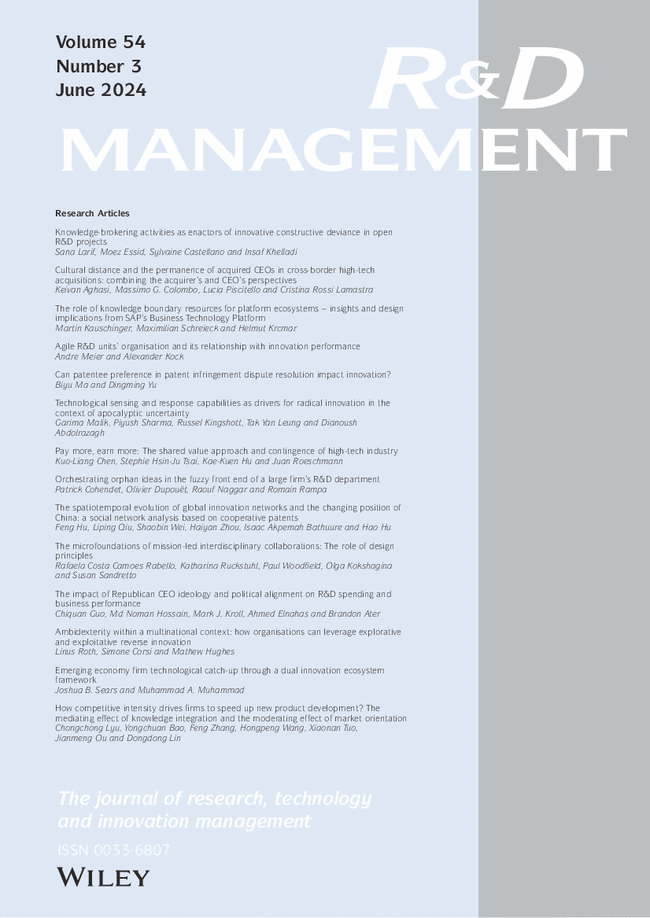Limits of open innovation during the organizational change: a case study of a Partner Campus
IF 5.7
2区 管理学
Q1 BUSINESS
引用次数: 0
Abstract
The literature on open innovation (OI) has mainly been focused on the ‘bright side’ of OI, thus neglecting the limits of OI implementation influencing innovation processes during organizational change. It requires to develop a better understanding about the limits of OI. Therefore, this study explores the limits of OI during organizational change and provides approaches that drive firms to offset these limits. The empirical analysis is based on an in‐depth single case study and data was collected through semi‐structured interviews with the representatives engaged with Partner Campus – an OI initiative developed by a multinational manufacturing company. We have found that during the change process of adapting collaborative and absorptive capabilities, and developing organizational readiness, several internal and external challenges limit the company's drive to open up. Internal challenges arise when organizations start the change process in unfreezing stage. The traditional organizational culture and structure challenge incumbent firms to break the existing silos and utilize knowledge and resources effectively for OI implementation, hindering intra‐organizational collaboration. While external challenges arise when organizations transform their endeavors across organizational boundaries and collaborate with external stakeholders. When firms lack knowledge integration and technological capabilities, OI creates collaborative complexity given the magnitude of involved diverse actors and activities at different levels, which challenges the organizations to maintain the longevity of OI practices, resulting in several risks that limit firms to open up. However, we have identified the capabilities and actions that firms can take to strengthen a collaborative environment by counterbalancing these challenges. We contribute to the literature on OI by identifying and assessing the limits of OI, embedded in the organizational change process, that hinder organizational drive for OI. We also contribute to organizational change literature by identifying specific changes related to organizational processes, structure, and culture, and outlining approaches that can support a smooth transition.组织变革期间开放式创新的局限性:伙伴校园案例研究
有关开放式创新(OI)的文献主要集中于开放式创新的 "光明面",从而忽视了开放式创新实施在组织变革过程中影响创新进程的局限性。这就需要更好地了解开放式创新的局限性。因此,本研究探讨了组织变革期间开放式创新的局限性,并提供了推动企业抵消这些局限性的方法。实证分析以深入的单一案例研究为基础,通过对参与伙伴校园(一家跨国制造公司开发的开放式创新举措)的代表进行半结构化访谈收集数据。我们发现,在适应协作和吸收能力以及发展组织准备的变革过程中,一些内部和外部挑战限制了公司的开放动力。当组织在解冻阶段开始变革过程时,内部挑战就会出现。传统的组织文化和结构使现有企业难以打破现有的 "孤岛",难以有效利用知识和资源来实施开放式创新,从而阻碍了组织内部的协作。而当组织跨越组织边界进行转型并与外部利益相关者合作时,外部挑战就会出现。当企业缺乏知识整合和技术能力时,由于涉及不同层面的不同参与者和活动,开放式创新会产生合作的复杂性,这对组织保持开放式创新实践的持久性提出了挑战,从而导致限制企业开放的若干风险。不过,我们已经确定了企业可以采取的能力和行动,以通过抵消这些挑战来加强合作环境。我们通过识别和评估组织变革过程中的开放式创新限制,为有关开放式创新的文献做出了贡献,这些限制阻碍了组织对开放式创新的推动。我们还确定了与组织流程、结构和文化相关的具体变革,并概述了可支持平稳过渡的方法,从而为组织变革文献做出了贡献。
本文章由计算机程序翻译,如有差异,请以英文原文为准。
求助全文
约1分钟内获得全文
求助全文
来源期刊

R&D Management
Multiple-
CiteScore
11.30
自引率
9.50%
发文量
0
期刊介绍:
R&D Management journal publishes articles which address the interests of both practising managers and academic researchers in research and development and innovation management. Covering the full range of topics in research, development, design and innovation, and related strategic and human resource issues - from exploratory science to commercial exploitation - articles also examine social, economic and environmental implications.
 求助内容:
求助内容: 应助结果提醒方式:
应助结果提醒方式:


